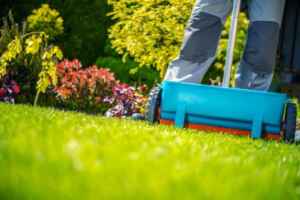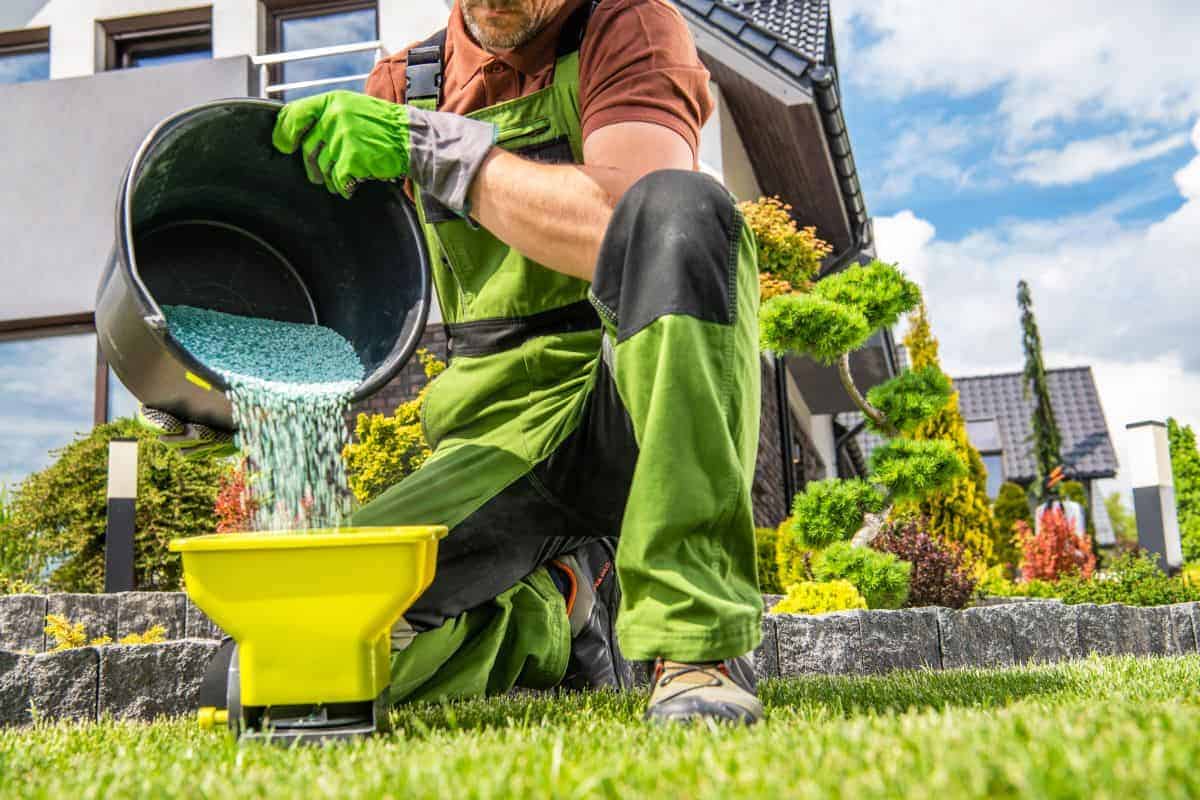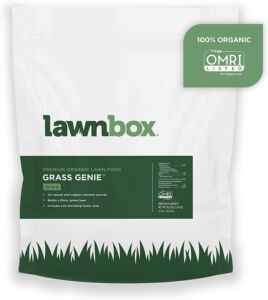Every homeowner desires a pristine lawn. However, having a healthy and green lawn takes work. I have always wanted a lawn I could be proud of that could win an award for the best lawn on the block! So I went to work researching what it takes to have a great lawn. One of the main things I discovered is the benefits of fertilizer to grow and maintain your lawn. Knowing that fertilizer is needed is just part of the battle. You have to know when to fertilize your lawn for the best results. There is more to this than you think! All lawns and grass are not built alike. When is it too late to fertilize your lawn? Is May too late? Is it best to fertilize earlier or later? In this post, you will benefit from my research to find out exactly when you should fertilize your lawn.
Many details matter when deciding when to fertilize your lawn. Two of the main elements that will help you determine when you need to fertilize your lawn are where you live and the type of grass you have. Where you live impacts the climate your grass is attempting to grow. There is a prime ground temperature optimal for fertilizing your lawn for different types of grass. For most types of grass, the ground should be 55 degrees Fahrenheit.
In this post, I will discuss most of what you need to know to be able to know when to fertilize your lawn for the best results. You will never have a question about what month to fertilize your lawn. You will always be right on time and have a spectacular-looking lawn every season.
 Know Exactly When to Fertilize Your Lawn
Know Exactly When to Fertilize Your Lawn
A few critical indicators will help you determine the best time to fertilize your lawn. One of the essential items which will assist you in knowing when to fertilize your lawn is where you live. Where you live will determine when the ground temperature is best for fertilizer. Grass should be fertilized at a minimum twice per year generally. However, your frequency is based on your climate and the type of grass you have. Optimally, it is best to fertilize your lawn when the ground is 55 degrees Fahrenheit. Another vital factor to be aware of is the type of grass your lawn has. Do you have warm-season grass or cool-season grass? Cool-season grasses are primarily found in the Northern parts of the United States. Kentucky bluegrass, tall and fine fescues, and ryegrass are the most common. Cool-season grasses thrive in lower temperatures. They grow best in the early spring (right after winter) and early fall. Warm-season grasses do best in the southern-most areas of the United States. They need warmer temperatures to thrive. Therefore, midsummer is their best growing season. There are four major types of warm-season grasses. They are Bermuda grass, centipede grass, St. Augustine grass, Kikuyu grass, and zoysia grass. You can also have a mixture of warm and cool-season grasses. This means you will need to fertilize your lawn at different times based on the type of grass. An easy way to recognize the type of grass you may have is to notice what your lawn does. Does your lawn turn brown after your area’s first frost? If so, you most likely have warm-season grass. Does your lawn stay green all year long, especially when cool? Then that is cool-season grass. Even with cool-season grass, excessive heat is detrimental to the grass. Your grass’s growing season must be known to determine when to fertilize your lawn. For cool-season grasses, the growing season is spring and fall (so not May). Average temperatures during this season should be between 60 and 70 degrees Fahrenheit. The best growing period for warm-season grasses is late spring and summer (May will fall into this range). This is generally when temperatures average 80 to 95 degrees Fahrenheit. This is why where you live is so important to answer this question. Fertilization times will be vastly different if you live in Florida versus Michigan due to the weather.
How Often Should You Fertilize the Grass?
Once you know when to fertilize your grass, the next question is how often you should do it! You should fertilize your grass four times annually. One of the best types of fertilizer is organic slow-release fertilizer. You should apply the fertilizer at the beginning of the growing season of the grass. This will help the fertilizer have the nutrients required to support the grass to take root and grow as expected. Your first batch of fertilizer should be applied when the soil reaches 55- degrees Fahrenheit. A couple of ways you can tell the temperature of your soil is by examining if other flowers have begun to bloom or grass has begun to sprout. Another way to determine your soil’s temperature is to get a lawn thermometer. After your first fertilizer application, you should apply fertilizer every six to eight weeks. After the first application, you should continue applying fertilizer every six to eight weeks.
 How Soon Can Your Fertilize After Seeding Your Lawn?
How Soon Can Your Fertilize After Seeding Your Lawn?
You should fertilize after seeding your lawn at the beginning of your lawn’s growing season. This usually occurs four to six weeks after the seed germinates. Some individuals recommend using a“starter fertilizer“
when you are prepping the lawn for seeding. This slow-release fertilizer will supply nutrients to your soil prior to grass growing. You also must water your grass immediately after seeding. If you re-fertilize too early, you run the risk of the nutrients not being absorbed by the roots. If you end up overfertilizing your grass, you can run the risk of contaminating your water or “burning” your grass which can turn it brown. You can also cause your lawn to grow too fast. This could lead to excessive required mowing or grass blades growing faster than the root system. You can have extreme organic matter, which can cause root disease, poor drainage, or rot. Lastly, excessive fertilizer can disrupt your soil’s ph balance. If your soil is too alkaline, it will not be able to absorb the nitrogen and phosphorus that your soil needs for growth. If your soil is too acidic, excessive nutrients like aluminum can become harmful to your soil and eventually kill your grass.
How Do You Choose the Best Fertilizer?
Choosing the best fertilizer for your lawn is essential to its growth and maintenance. There are many different types of fertilizer you can choose from. However, the biggest choice you will make is deciding whether to use organic or synthetic fertilizer. Organic fertilizer is best. It is natural and comes from plant or animal sources.
Lawnbox Grass Genie 10-0-6 100% Organic Spring Grass Fertilizer
Organic fertilizers are generally slow-release. Synthetic fertilizers work faster, and you will often see your grass turn green faster. However, it might not be the best for your lawn for sustainability. Other choices you will need to make include using quick-release or slow-release fertilizer. You will need to know how to read the NPK ratio of the fertilizer. This is the fertilizer’s amount of nitrogen, phosphorus, and potassium. Nitrogen helps keep your grass green, phosphorus assists with root growth, and potassium helps your grass withstand drought and disease. The combination of these nutrients you use will depend on your climate and the type of grass. You will need to research your specific grass type for the best balance of nutrients in your fertilizer.
 Related Questions
Related Questions
Can I apply fertilizer right after it rains? No, it is not best to apply fertilizer right after a rainstorm. The best practice is to wait a couple of days before fertilizing your grass, especially if the rain has thoroughly soaked your soil. This allows the ground to dry, so you do not create runoff and waste fertilizer. When your grass is dry, your fertilizer has a better opportunity to reach the soil instead of sticking to the grass blades.
Can I fertilize during a drought? It is not best to fertilize during a drought. Most fertilizers require that you water the lawn either before or after lawn fertilizer treatment. It is essential that you have a good watering routine for your lawn maintenance. You will also need to be careful not to overwater your lawn. This could be harmful to your lawn growth by saturating your grass before your yard has an opportunity to absorb the nutrients from your fertilizer.
Are there different ways to apply fertilizer? Yes, there are several different ways you can apply fertilizer. You can apply dry or liquid fertilizer. Dry fertilizer comes in the form of pellets, powders, or crystals. You can apply fertilizer directly to the soil or spread dry fertilizer on top of the ground evenly. This is called broadcasting or the topdress method. You can also spray fertilizer directly on your plant’s leaves. This works well with trees. Lastly, you can apply fertilizer in bands or rings around your plants. Once you purchase your fertilizer, the packaging will tell you the fertilizer’s preferred application method.



